On a morning drive at Kruger National Park, seeing a large group of buffalo approaching we stopped our car to watch. They came closer and closer and then they stopped too. We had thought that we were watching them, but it turned out that they were also watching us.

The herd of buffalo approached at an easy ambling pace. We assumed they were on a commute between grazing areas and water. Buffalo are water dependent and need to drink every day, especially in the dry months when their main food source is dry standing hay. As some youngsters were present we took this to be a breeding herd.
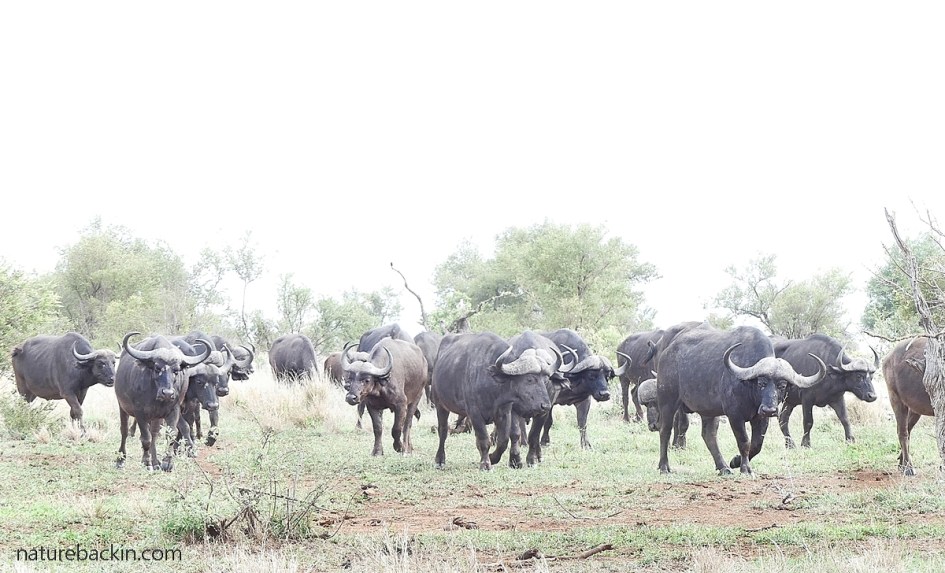
Buffalos are non-territorial and very sociable animals. Herd size depends on habitat and also on the availability of grazing. In dry months herds may disperse into smaller units. The small units may be clans, which consist of related cows and their offspring accompanied by a few dominant breeding bulls, or temporary bachelor herds comprising mature bulls and subadult males.

As we watched, we were surprised to see that the buffalo did not alter their direction but continued on their path towards us. These buffalo are African buffalo (Syncerus caffer). They are the only member of the Bovini tribe (which includes wild and domestic cattle and American bison) that occurs naturally in Africa. The Bovini tribe is part of the Bovidae family that includes also antelopes and sheep and goats.

The buffalo approached calmly, obviously walking with purpose without much stopping to graze. Buffalo are primarily grazers and use their prehensile tongues to grasp bite-sized bundles of grass. They are able to eat tall, mature grasses and in the winter they eat hay-like dry standing grasses. Herbs and foliage comprises only about 5% of their diet, and their preference is for grasses.

As the buffalos got closer to us some continued walking and others paused to graze. The male leading this group has noticeably heavy horns.
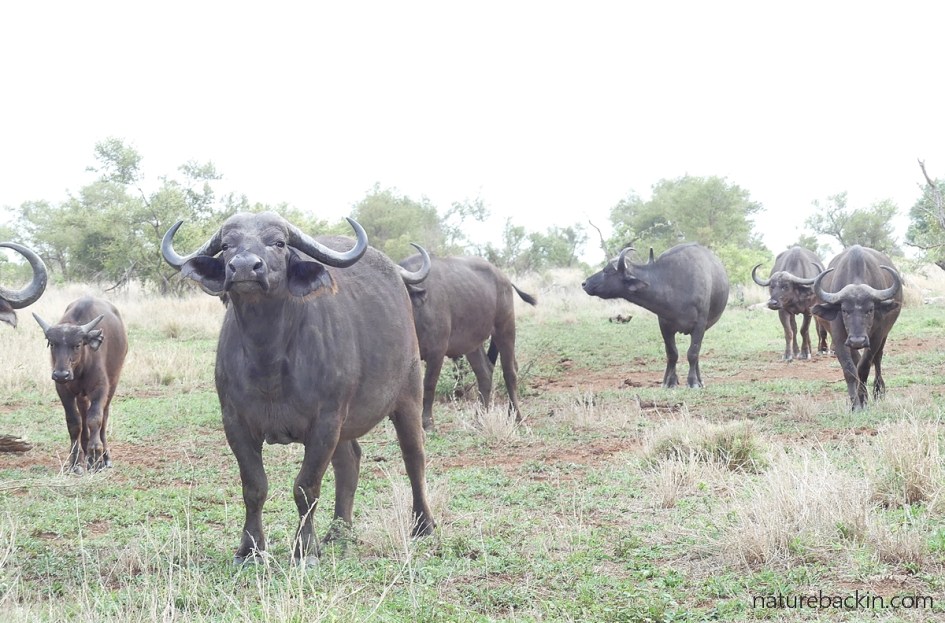
As they got closer still, some stopped to look at us, sniffing the air as they tried to figure out who or what we were. Their sense of smell is more developed than their sight or their hearing.

With the herd slowing down more animals started grazing as they moved and others, like this rather gentle looking female, stopped to stare at us – or at least at our vehicle.
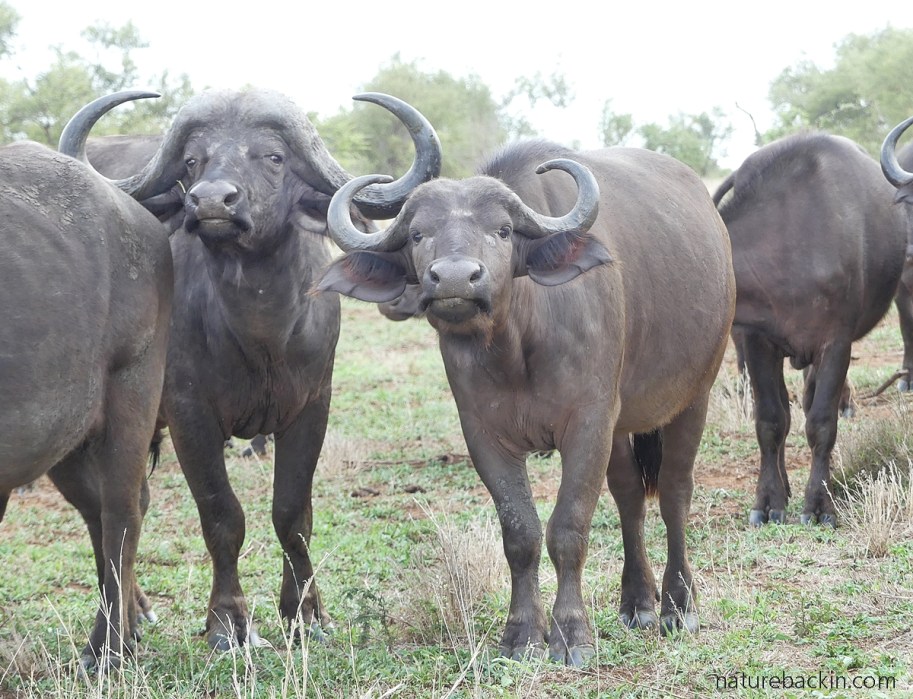
Some of the looks we got were quite quizzical. As we watched them watching us it became striking as to how individual and distinctive each buffalo is when one has the chance to see them ‘face-to-face’.
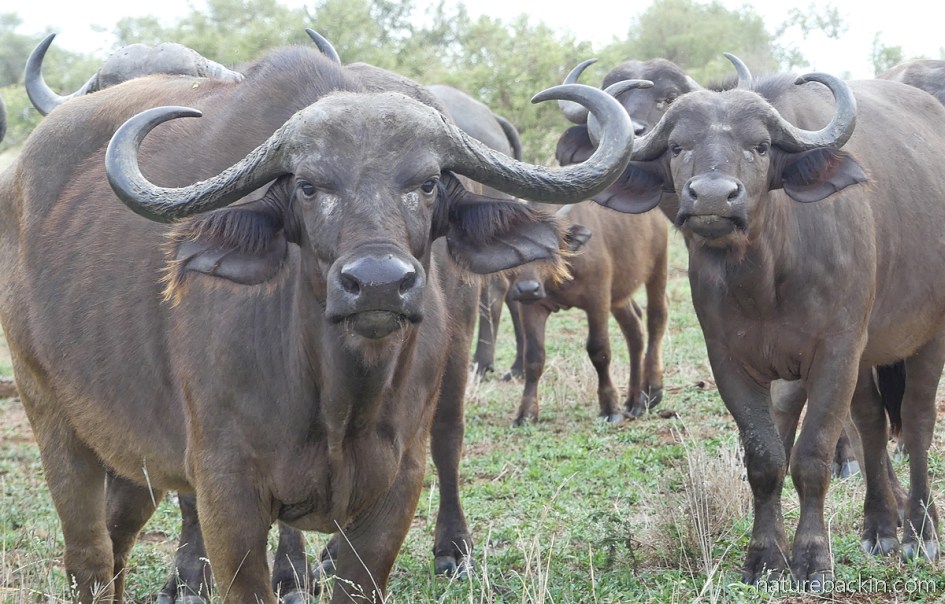
These females watched us with a kind of open frankness. Evidently they felt unthreatened and they seemed very placid. The mature female on the left displays lovely fringes on her drooping ears.
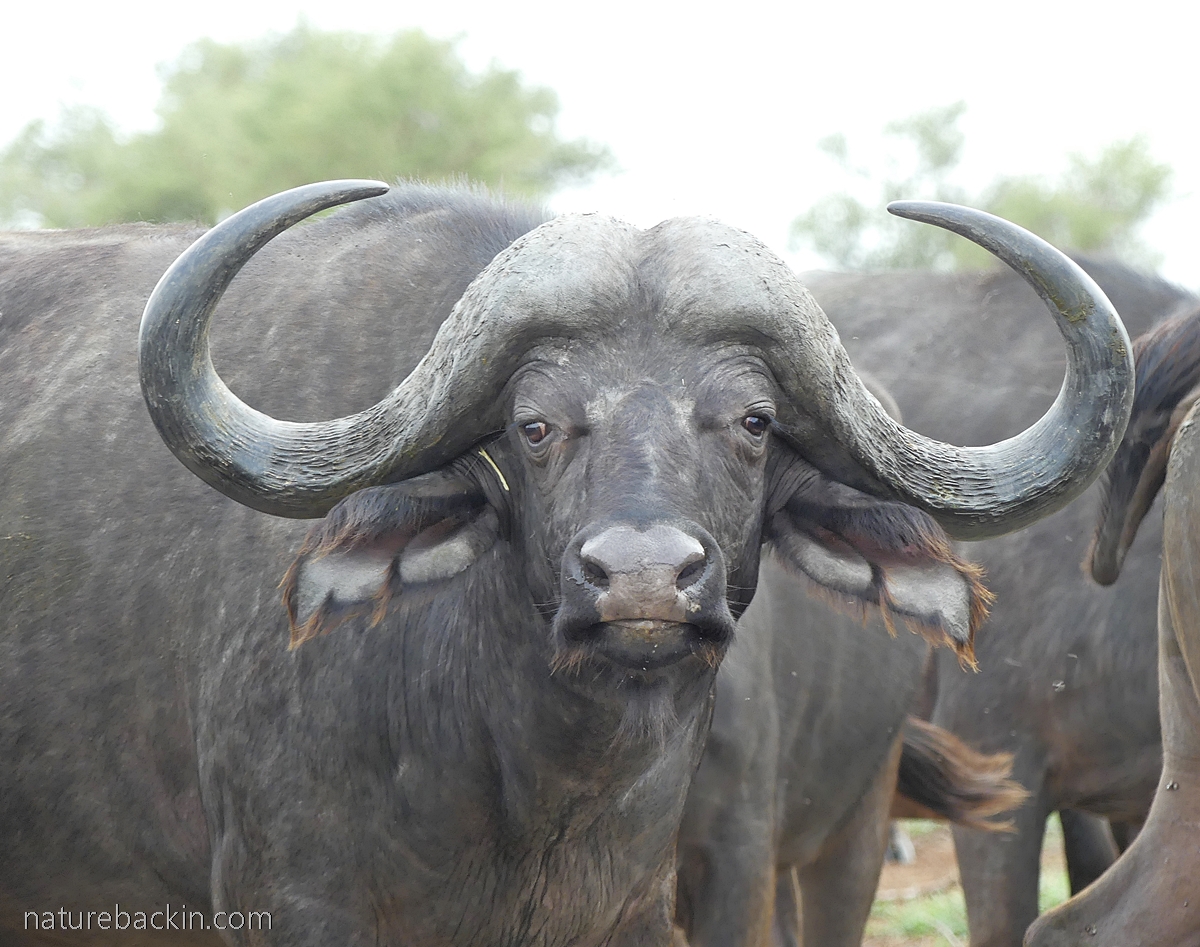
The base of the horns of male buffalos is more developed than in the females, the thick base or boss serves to protect the forehead.
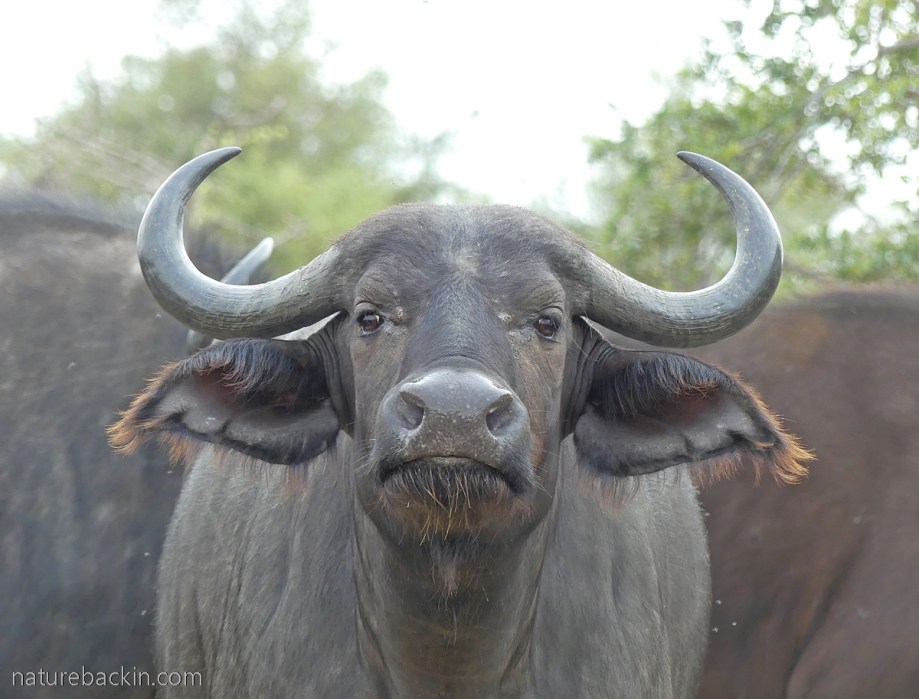
This female buffalo lifted her head and sniffed the air as she gazed at us.

This buffalo had tatty ears and despite her rather wide-eyed expression she seemed as placid as the others.
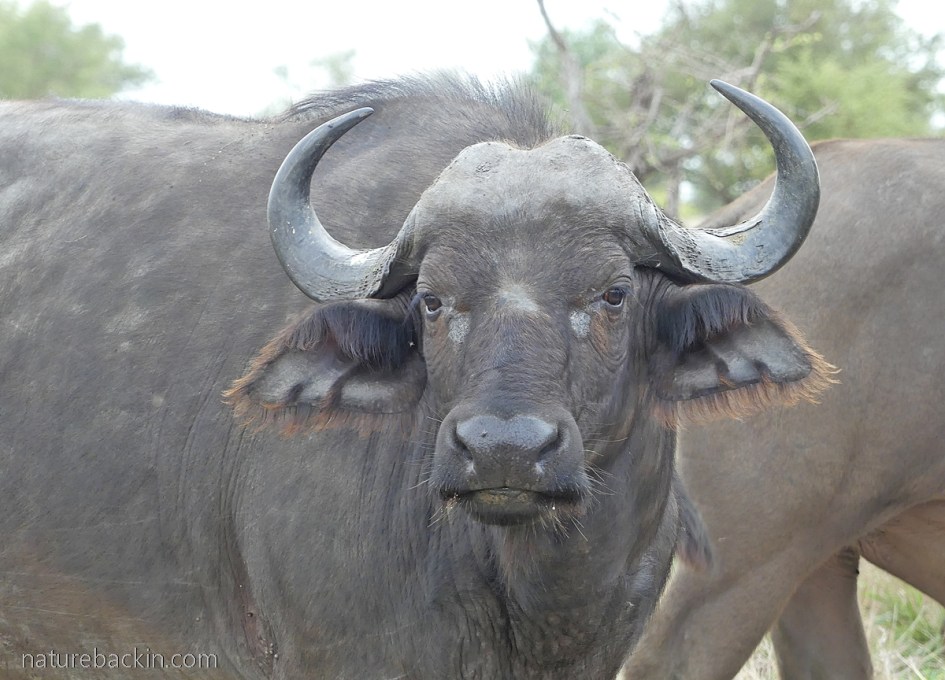
Another female buffalo had a far tidier appearance with her rather neatly fringed ears and gentle demeanour.

The buffalo in the foreground (in the above photo) walked calmly towards us while carrying an oxpecker on her back. Female buffalos reach breeding age when they are about five years old. The gestation period for buffaloes is 11.5 months and a healthy female with sufficient access to food may give birth to a subsequent calf after an interval of 15 months.

Bringing up the rear of the herd was this group. The buffalo in the front had unusually fluffy knees.
Buffalo have a reputation for being dangerous animals, but this usually applies if they are wounded or if they are cornered or feel threatened. In areas where they are persecuted by people they are nocturnal, but in protected areas free from hunting they will feed also during the day.
Our quiet morning encounter with these African buffalo was one of the highlights of our recent visit to Kruger National Park
Sources:
Dorst, Jean & Dandelot, Pierre. 1984. A Field Guide to the Larger Mammals of Africa. London: Collins; Estes, Richard. 1993. The Safari Companion a Guide to Watching African Mammals. Halfway House:
Russel Friedman.
Posted by Carol

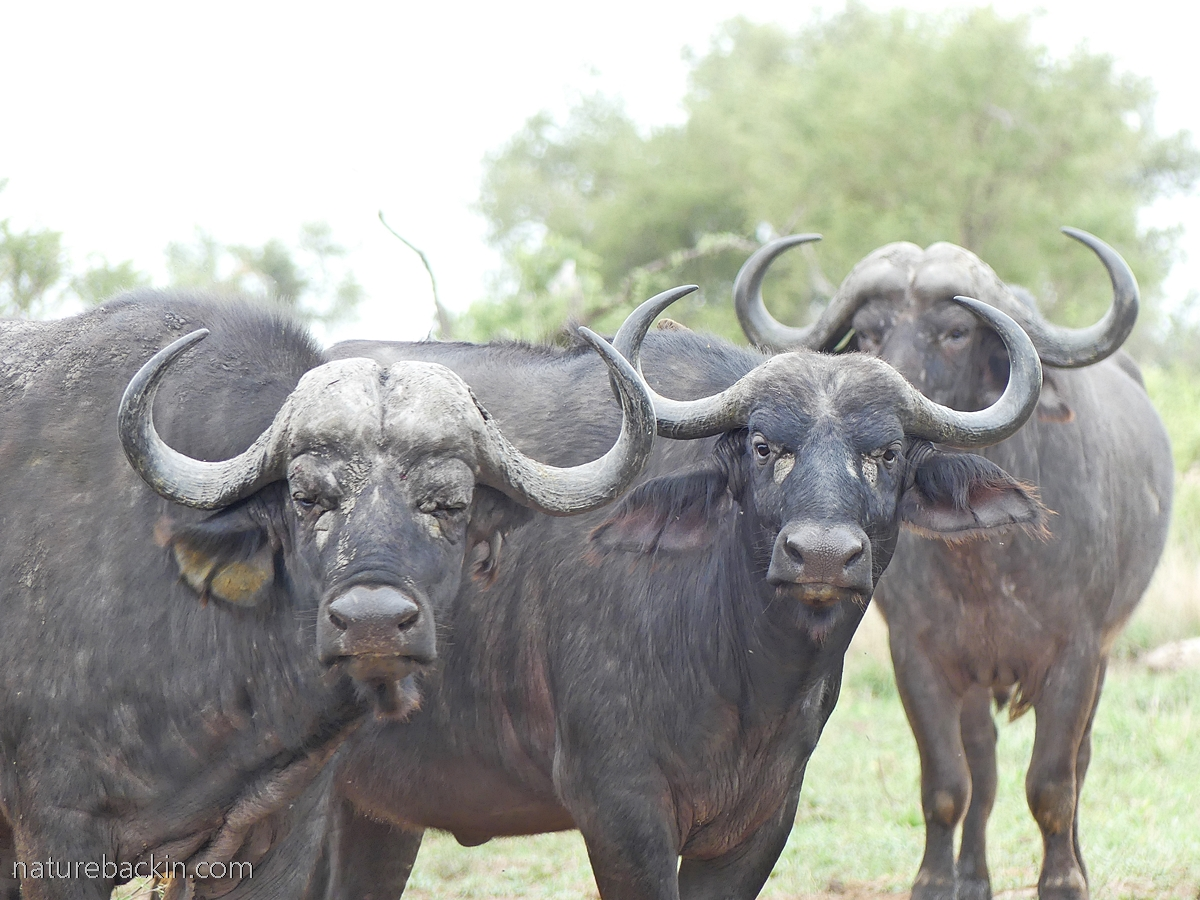







February 4, 2022 at 9:42 pm
I loved looking at each face. This was very special. Thank you
LikeLiked by 1 person
February 8, 2022 at 5:08 pm
And thank you. It is fascinating to see how individual they are!
LikeLike
January 29, 2022 at 12:30 am
It’s wonderful you were able to get near the buffalos, have time to observe them closely, and notice so many differences between the individuals one would never notice from far away at a quick glance.
LikeLiked by 1 person
January 29, 2022 at 8:22 pm
Yes you are right – seeing a herd from a distance they all look alike, so it is interesting to be able to see how individual they really are.
LikeLiked by 1 person
January 23, 2022 at 12:14 pm
What a remarkable encounter. In that situation I don’t think I would have found these creatures placid and gentle! They are magnificent, but rather imposing, from such close quarters!
Their ears, especially, fascinated me. They seem to be oddly placed and delightfully fluffy
LikeLiked by 1 person
January 24, 2022 at 3:33 pm
Yes they are magnificent and the fluffy ears are in rather surprising contrast to their imposing presence. However, the demeanor of these animals was very calm and some of them had very gentle expressions. We took care to stay still and silent so as not to do anything surprising. My field guides say that buffalos in herds are usually placid unless provoked – and one also adds that buffalos are often inquisitive too 🙂
LikeLiked by 1 person
January 23, 2022 at 1:32 am
I enjoyed studying the various traits of these placid buffalos from the beautiful photos you captured. I’ve heard so many stories of our Bison acting aggressively toward the tourists at Yellowstone. I can’t help but wonder if our buffaloes get annoyed with the folks who are often rude and annoying toward them. It’s just lovely that you had this chance to peacefully watch them watch you and everyone got along! 🤗
LikeLiked by 1 person
January 24, 2022 at 3:27 pm
Absolutely it was lovely. We were lucky that no other vehicle came by when we were there, so we were able to sit in silence and watch them watching us, and it was all very peaceful.
When previously we have seen tourists being noisy or inconsiderate – like most wild animals – the groups of buffalos we have seen in such circumstances have run away, although of course this response is not to be assumed. Also, it might be different if a lone bull is provoked as they can be unpredictable as they are alone and unprotected by a group.
I sympathize with the American bison who get annoyed when they feel threatened or provoked.
LikeLike
January 24, 2022 at 10:55 pm
I’ve noticed how things have changed at our National Parks since I first visited them (late 1960s?) Some of the most beautiful places are being ‘loved to death’. Before the pandemic we used to camp at out-of-the-way places (as yet undiscovered perhaps). These days we find it easier to simply explore what’s closer to home. There’s not much to complain about with our surroundings.
Yes. Sympathy to the American bison… they do occasionally get to revenge according to the Darwin Principle. 😏
LikeLiked by 1 person
January 22, 2022 at 2:14 am
One can really see each one’s individuality from your excellent photos, Carol. Their horns are massive– I wouldn’t want to tangle with one of them!
LikeLiked by 1 person
January 24, 2022 at 3:19 pm
I was very struck by their individuality. Yes those horns are massive and they are very large animals best treated with quiet respect.
LikeLiked by 1 person
January 21, 2022 at 10:26 pm
I always thought that buffalo would be dangerous. What a different feeling I have about them now!
Did you know they were gentle beforehand, or were you frightened at first when they all started coming towards you? I loved your buffalo portraits, and what individuals they are! I’m so glad you got to experience these beautiful creatures up close.
Cheers,
Julie
LikeLiked by 1 person
January 24, 2022 at 3:18 pm
Hi Julie – I think that buffalo have a reputation for being dangerous because when wounded or threatened buffalo can and do retaliate. Also a lone buffalo can be a edgy and unpredictable if he feels vulnerable out on his own. However, most guide books say that buffalos in herds are generally placid unless provoked in some way.
Over the years, when seeing buffalos in herds we have never seen aggressive behaviour. In this case, we could see the buffalo were calm when approaching. We kept still and quiet and they chose to approach us and they were not cornered or threatened in any way.
Once years ago when we were enjoying watching a very large herd of quietly grazing buffalos that surrounded the road we were on, a car drove up behind us, the driver got out of his car, slammed the door, ignored the buffalos and walked up to us and asked loudly if we had seen any rhino! Upshot was that without any hesitation the buffalo fled. Amidst our disappointment, the dust and the sound of thundering hooves we were at a loss what to say!
LikeLiked by 1 person
January 25, 2022 at 11:11 pm
How interesting, and what a sad story about those clueless visitors!
LikeLiked by 1 person
January 21, 2022 at 5:22 am
What a great encounter and such good photos and observations, though I don’t think I’d want to tell the one in the last photo that it had fluffy knees. It might not appreciate the comment!
LikeLiked by 1 person
January 24, 2022 at 3:05 pm
Thanks Graham. I am sure you are right about not pointing out the fluffy knees 🙂
LikeLiked by 1 person
January 21, 2022 at 4:18 am
I have enjoyed your illustrated narrative. Buffalo have a wizened look about them and I too have noticed their individual expressions when we have been surrounded by them at Addo. You gained a lot by parking and simply watching their behaviour.
LikeLiked by 1 person
January 24, 2022 at 3:03 pm
Absolutely – it is so rewarding to park and sit quietly and simply watch what happens. We did very low mileages in the park as we spent a lot of time in one place or another just observing behaviour. For example, one morning we were surprised to find we had spent 6 engrossing hours on an 11 km stretch of road near Shimuweni camp!
LikeLike
January 24, 2022 at 6:02 pm
I am not at all surprised.
LikeLiked by 1 person
January 25, 2022 at 8:35 pm
🙂
LikeLike
January 21, 2022 at 3:33 am
Even when they’re as placid as this herd, there’s always that air of latent power and aggression when faced by an approaching herd of buffaloes – especially when they stare at you down their noses. An experience I could never tire of.
LikeLiked by 1 person
January 24, 2022 at 2:58 pm
The certainly are powerful but I think when they stare down they noses they are using their senses to work out what/who they are encountering. As they chose to approach us – we stayed quiet and in one place – it would seem they were slightly inquisitive as they could easily have avoided us. It was a wonderful experience.
LikeLiked by 1 person
January 25, 2022 at 2:27 am
Don’t you wish you were back in Kruger too, Carol? Such a magical place.
LikeLiked by 1 person
January 25, 2022 at 8:36 pm
Absolutely!
LikeLiked by 1 person
January 21, 2022 at 2:31 am
Lovely post Carol! Observing these beautiful, placid buffalos must have been an incredibly special time, xxx
LikeLiked by 1 person
January 24, 2022 at 2:55 pm
It absolutely was a very special time.
xxx
LikeLiked by 1 person
January 20, 2022 at 9:27 pm
What a really special experience! And a lovely photographic record.
LikeLiked by 1 person
January 24, 2022 at 2:53 pm
Thanks Margaret, it was special. It’s nice to take things slow and have the time to wait and watch things unfold.
LikeLiked by 1 person